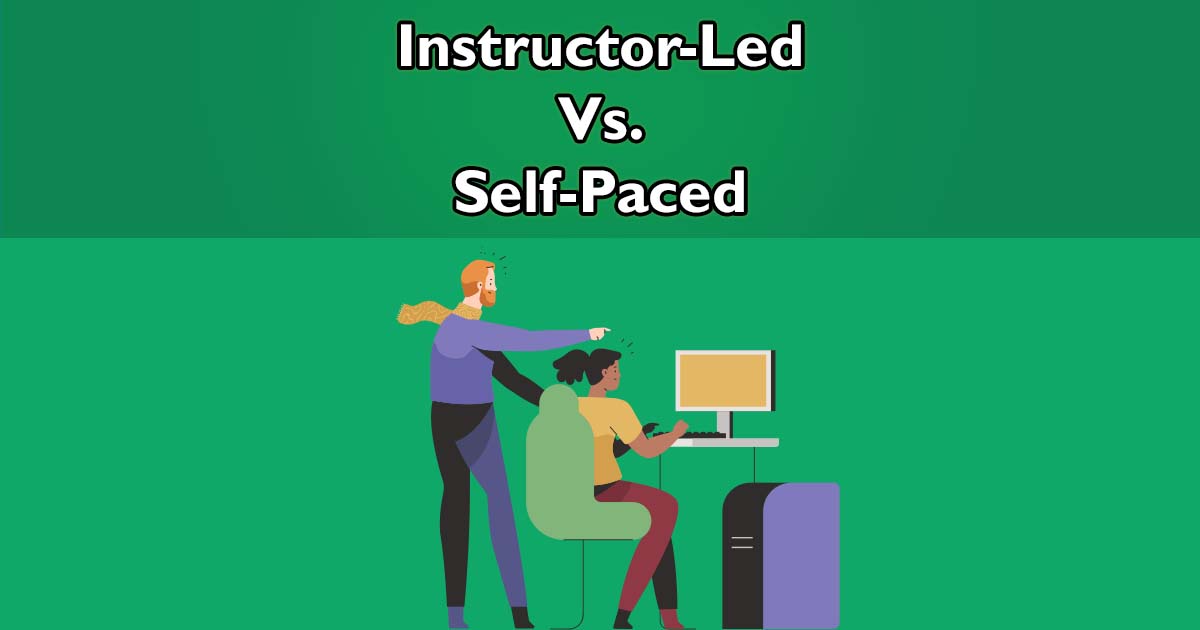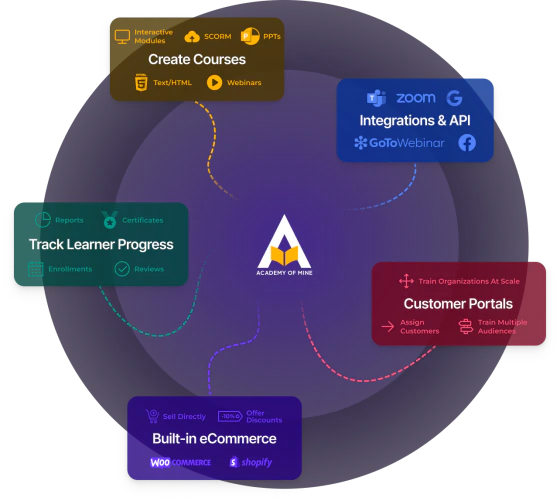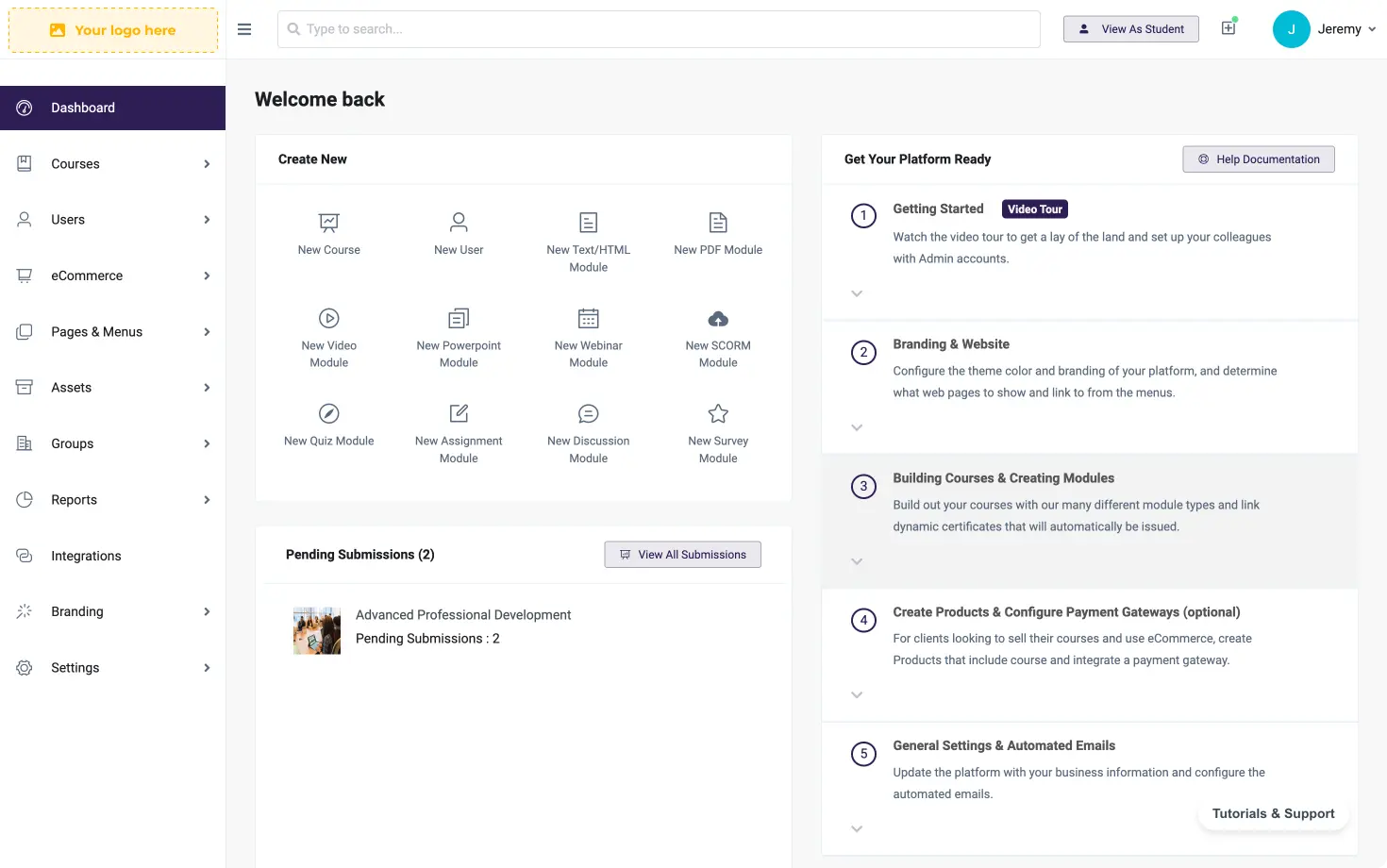eLearning Software, Self Paced Learning, Webinar
Instructor-Led Training Vs. Self-Paced Learning

In 2021, a LinkedIn study was conducted, which resulted in 64% of global L&D experts saying learning & development had shifted from “nice to have” to “need to have”. It’s clear that there’s a growing demand for virtual training with webinars and self-paced learning. Between the two types of virtual training, which one is the champion?
Both instructor-led training and self-paced learning have their pros and cons, and in this article, we’re going to discuss them in-depth–to help you understand which is the best solution for you.
What is Instructor Led-Training (ILT)?
Instructor-led training has been going on since 1635 when the first public school in America was founded. To be fair, it was probably going on long before that in a less formal way. For example, men taught boys to hunt in the hunter and gatherer days. Staying on track, ILT is any type of formal training that is led by a subject matter expert. For example, a sales manager training an entry-level sales rep, an OSHA instructor teaching safety practices to electrical engineers or forklift drivers, and yes, a high school teacher instructing kids.
The practice of ILT used to only be available in person, but thanks to the learning management systems (LMSs) and the internet, instructor-led training sessions are hosted virtually all the time now. Not only is virtual ILT possible, but it’s also extremely popular; using ILT, your business can engage in conversations with customers, partners, and employees, face to face virtually. ILT is great for creating training programs that are flexible for the end-user but are also effective.
What is Self-Paced Learning?
If you’re intrigued by the convenience of ILT, but want to create a training program that involves less of your instructor’s time, this next type of virtual training is for you. Self-paced learning is any type of training that’s designed for users to go through a course in their own time. For example, taking an online course made of videos, quizzes, and other interactive exercises to test trainees’ knowledge. The contents–otherwise known as training materials inside of a course–are created in advance and made accessible to learners 24/7.
Self-paced learning is the self-service model for virtual training. Although this may seem like students are all alone during training, there’s still interaction between students and instructors if your courses are made up of interactive assignments.
Instructor-Led Training vs. Self-Paced Learning
If we could sum up each type of virtual training using only two words: ILT would be engaging and personal, and self-paced learning would be convenient and scalable.
Benefits of ILT
Instructor-led training is the bridge between self-paced learning and traditional learning in a physical location. Why? Because it happens in real-time over the internet, and the only main difference between sitting in a classroom with others is you can’t reach out and touch a person. Although ILT isn’t as cost-effective as self-paced training, it’s still immensely more affordable than in-person learning, and it’s effective.
Since webinars involve speaking and seeing real people in real-time, attendees are usually focused, engaged, and involved in the training session. ILT is the most engaging form of virtual training, and for instructors and professionals-in-training, it’s similar to learning in a physical location but at a fraction of the cost.
Answering questions and resolving problems over a webinar is another reason why ILT is convenient. Unlike self-paced learning, where you would have to email or message someone if you have a question, with ILT you can just ask instructors right then and there. Another advantage of training with webinars is that it gives instructors real-time insights into how knowledgeable their students are in a topic.
Drawbacks of ILT
Unfortunately, time zones can be a massive problem for ILT. For example, let’s say a webinar is being hosted at 2 pm in New York City, but for the customer in China that purchased a webinar seat, it’s 2 am their time! Similarly, schedule conflicts can arise in ILT, since everybody participating has to meet at the same time around the world.
Another drawback of Instructor-led training is the internet speed of users and instructors. For example, since webinars are hosted online, if one student has a bad connection then only they will be negatively affected. However, when the host of a webinar has a bad internet connection then everyone enrolled in the webinar will suffer as a result! Making sure all users enrolled in a webinar (including the host) have a decent internet connection can prevent negative live training experiences.
Benefits of self-paced learning
A few obvious advantages to self-paced learning are price and convenience. Since self-paced training content like PDFs, videos, and SCORM files are created once and can be reused, it’s affordable for companies to train at scale with this type of virtual training.
Self-paced courses, otherwise known as on-demand courses can be taken advantage of by professionals in different industries all around the world; a physical therapist (PT) in Atlanta, Georgia can benefit from taking a self-paced training course just as much as a PT in Hong Kong, China. If your company is using a cloud-based LMS to manage self-paced learning, all your users need to take courses is an internet connection and a computer or smart device.
Self-paced learning for employees, customers, and other stakeholders is loved for the same reason that shoppers love the self-checkout lane in grocery stores–it’s convenient. Deadlines and regulations are still usually enforced with self-paced training, but a company’s capabilities as to what’s being regulated depend on the power of their LMS.
Last but not least, when you manage self-paced courses inside of an LMS like Academy Of Mine, you can report on users’ performance and grades in one place.
Drawbacks of self-paced learning
Some companies have concerns about user engagement in self-paced learning–in fact, we get this question all the time, “if a course is automated and pretty much self-serving, how focused and engaged can my customers be while training?” It makes sense to think this, but if you’re managing self-paced courses and are struggling with user engagement, it probably has more to do with your course’s structure than the style of virtual training itself.
More specifically, if you’re managing a sexual harassment training course that seems to be boring employees to death, but the whole course consists of word documents and videos, the course is simply not engaging employees enough. Working with instructional designers and companies who are educated on your training use-case and industry can prevent this from happening.
Lastly, asking a question in self-paced learning programs can be more difficult than in ILT. Since training happens asynchronously with this style of learning, users have to send a message or email to training managers and instructors if they need help. Using a system that’s optimized for helping students answer questions, this bit of added friction when it comes to asking for help in a course shouldn’t be a problem.
In our experience, customers are satisfied by just listing their email addresses in a course for students to reach out to when they need help.
Why You Should Consider Using Both (Blended Learning)
There are pros and cons to both ILT and self-paced learning. Why settle for webinars, or self-paced courses when you can use both with an LMS? As we touched on earlier, the drawbacks of ILT can be made up by the befits of self-paced learning, and vice versa. For instance, If your company sees a benefit in hosting regular webinars for customers–to save money–instead of eliminating webinars from your training programs, just host fewer of them. Fill in the gaps with self-paced training courses.
When selling continuing ed and compliance courses online, blended learning gives customers more options to choose from.
So if you’re ready to step up your training programs using blended learning, Get Started with us today!

